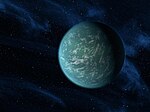Kepler-20
Planetary system

On December 20, 2011, the Kepler Space Telescope team reported the discovery of a five-planet system containing three small gas giants and the first two Earth-sized extrasolar planets, Kepler-20e (the first known extrasolar planet smaller than Earth orbiting a main-sequence star) and Kepler-20f, orbiting a Sun-like star. Although the planets are Earth-sized, they are not Earth-like in the respect that they are much closer to their star than Earth, and are hence not near the habitable zone, with expected surface temperatures of 760 °C (1,400 °F) and 427 °C (801 °F), respectively. The three other Neptune-sized planets in the system, Kepler-20b, Kepler-20c, and Kepler-20d, all orbit similarly close to the star.
Only upper limits on the masses of e and f are known. Their masses are uncertain as they are too small to detect via radial velocity with current technology. As of 2023, Kepler-20e is known to be less massive than Earth.
A 2016 study detected a sixth planet in the system based on radial velocity observations. Kepler-20g may be a non-transiting Neptunian world. However, the existence of this planet was challenged in 2019, and a non-detection was reported in 2023. Another 2023 study listed this planet, though the data used was identical to the 2016 study except for the addition of a single data point, and the dispute was not addressed.
All planets are at small near resonances; proceeding outwards, they are 3:2, 4:2, 2:1, 4:1. The planetary orbits in current form are highly sensitive to perturbations caused by outer planets, therefore assuming stability, no additional gas giant planets can be located closer than 30 AU from the parent star.
| Companion (in order from star) |
Mass | Semimajor axis (AU) |
Orbital period (days) |
Eccentricity | Inclination | Radius |
|---|---|---|---|---|---|---|
| b | 9.7±1.3 M🜨 | 0.04565±0.00089 | 3.6961049(16) | <0.083 | 87.36+0.22 −1.6° |
1.773+0.053 −0.030 R🜨 |
| e | <0.76 M🜨 | 0.0637±0.0012 | 6.0984882(99) | <0.092 | 87.63+1.1 −0.13° |
0.821±0.022 R🜨 |
| c | 11.1±2.1 M🜨 | 0.0936±0.0018 | 10.8540774(21) | <0.076 | 89.815+0.036 −0.63° |
2.894+0.036 −0.033 R🜨 |
| f | <1.4 M🜨 | 0.1387±0.0027 | 19.578328(48) | <0.094 | 88.788+0.43 −0.072° |
0.952+0.047 −0.087 R🜨 |
| g (disputed) | ≥19.96+3.08 −3.61 M🜨 |
0.2055+0.0022 −0.0021 |
34.940+0.038 −0.035 |
≤0.16 | — | — |
| d | 13.4+3.7 −3.6 M🜨 |
0.3474±0.0067 | 77.611455(96) | <0.082 | 89.708+0.17 −0.053° |
2.606+0.053 −0.039 R🜨 |
See also
References
- ^ Vallenari, A.; et al. (Gaia collaboration) (2023). "Gaia Data Release 3. Summary of the content and survey properties". Astronomy and Astrophysics. 674: A1. arXiv:2208.00211. Bibcode:2023A&A...674A...1G. doi:10.1051/0004-6361/202243940. S2CID 244398875. Gaia DR3 record for this source at VizieR.
- ^ Lasker, Barry M.; et al. (August 2008), "The Second-Generation Guide Star Catalog: Description and Properties", The Astronomical Journal, 136 (2): 735–766, arXiv:0807.2522, Bibcode:2008AJ....136..735L, doi:10.1088/0004-6256/136/2/735, S2CID 17641056
- ^ "Kepler-20 -- Star", SIMBAD, Centre de Données astronomiques de Strasbourg
- ^ Bonomo, A. S.; Dumusque, X.; et al. (September 2023). "Cold Jupiters and improved masses in 38 Kepler and K2 small planet systems from 3661 HARPS-N radial velocities. No excess of cold Jupiters in small planet systems". Astronomy & Astrophysics. 677: A33. arXiv:2304.05773. Bibcode:2023A&A...677A..33B. doi:10.1051/0004-6361/202346211. S2CID 258078829.
- ^ Johnson, Michele (20 December 2011). "NASA Discovers First Earth-size Planets Beyond Our Solar System". NASA. Retrieved 20 December 2011.
- ^ Sherrod, P. Clay; Koed, Thomas L. (2003), A Complete Manual of Amateur Astronomy: Tools and Techniques for Astronomical Observations, Astronomy Series, Courier Dover Publications, p. 9, ISBN 0-486-42820-6
- ^ "The Colour of Stars", Australia Telescope, Outreach and Education, Commonwealth Scientific and Industrial Research Organisation, December 21, 2004, archived from the original on 18 March 2012, retrieved 16 January 2012
- ^ Fressin, Francois; et al. (February 2012). "Two Earth-sized planets orbiting Kepler-20". Nature. 482 (7384): 195–198. arXiv:1112.4550. Bibcode:2012Natur.482..195F. doi:10.1038/nature10780. PMID 22186831. S2CID 3182266.
- ^ Schneider, Jean, "Star : Kepler-20", Extrasolar Planets Encyclopaedia, archived from the original on 2012-01-19, retrieved 2011-12-21
- ^ NASA Staff. "Artist's Concept of Kepler-20e". NASA. Retrieved 19 November 2014.
- ^ NASA.gov
- ^ Hand, Eric (20 December 2011). "Kepler discovers first Earth-sized exoplanets". Nature. doi:10.1038/nature.2011.9688. S2CID 122575277.
- ^ Overbye, Dennis (20 December 2011). "Two Earth-Size Planets Are Discovered". New York Times. Retrieved 2011-12-21.
- ^ Tate, Karl (20 December 2011). "At Last, Earth-Sized Alien Worlds (Infographic)". Space.com. Retrieved 2011-12-21.
- ^ Buchhave, Lars A.; et al. (14 November 2016). "A 1.9 Earth radius rocky planet and the discovery of a non-transiting planet in the Kepler-20 system". The Astronomical Journal. 152 (6): 160. arXiv:1608.06836. Bibcode:2016AJ....152..160B. doi:10.3847/0004-6256/152/6/160. S2CID 216077870.
- ^ Weiss, Lauren M.; et al. (2024-01-01). "The Kepler Giant Planet Search. I. A Decade of Kepler Planet-host Radial Velocities from W. M. Keck Observatory". The Astrophysical Journal Supplement Series. 270 (1) 8. arXiv:2304.00071. Bibcode:2024ApJS..270....8W. doi:10.3847/1538-4365/ad0cab.
- ^ Becker, Juliette C.; Adams, Fred C. (2017), "Effects of Unseen Additional Planetary Perturbers on Compact Extrasolar Planetary Systems", Monthly Notices of the Royal Astronomical Society, 468 (1): 549–563, arXiv:1702.07714, Bibcode:2017MNRAS.468..549B, doi:10.1093/mnras/stx461, S2CID 119325005
External links
- Multimedia:
- Video (01:33) NASA Discovers First Earth-like Exoplanet Orbiting A Sun-like Star.


